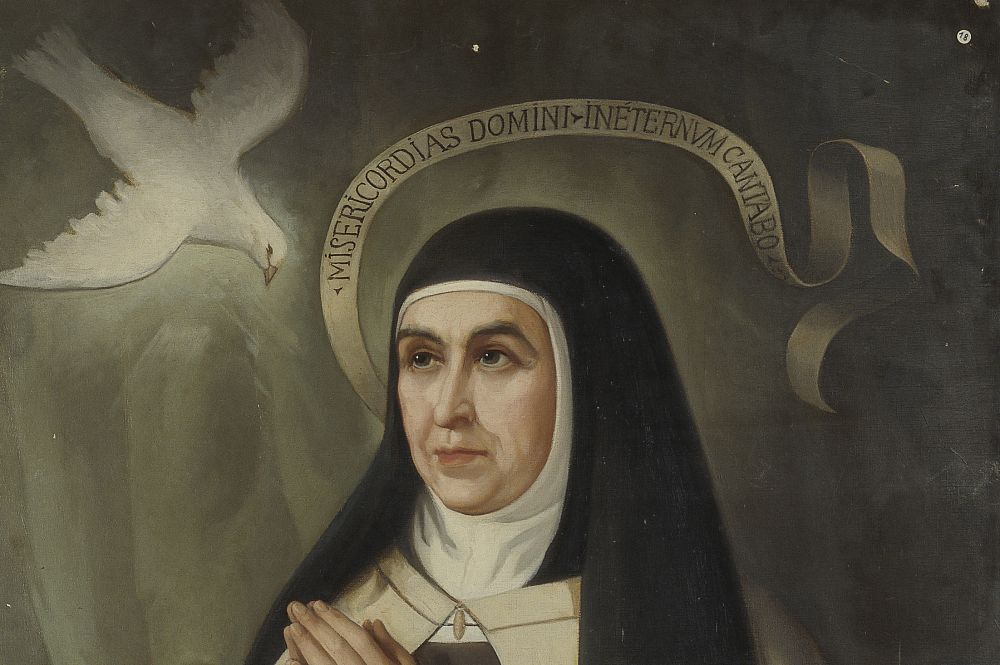
The Spirituality of St Teresa of Avila
What's a nun got to do with me?
What can a 16th-century Carmelite nun writing under the glare of the Spanish Inquisition offer a millennial, Anglican living in a post-Christendom Britain in terms of spiritual guidance? It’s a valid question given the huge chasm of experience between the two. Yet Teresa of Avila’s ‘masterpiece’ and ‘most systematic presentation of mystical experience’,[1] The Interior Castle, has been hailed as ‘a spiritual classic, whose insights transcend their own particular audience and time.’[2]
As part of her training, our ordinand Rachael was tasked with writing an essay exploring a specific spirituality and some of the reasons why this text, had become such a valued and referenced tool for spiritual insight and direction.
Here she explains why she chose to explore the life and seminal work of Teresa of Avila:
I chose St Teresa, partly because there are some pretty fun stories around her interactions with her spiritual leaders and critics. The more I read the more real she became to me and I love the smart, creative and gutsy woman I was beginning to picture. I found her quietly rebellious strength and rich visual imagery compelling. Focusing on her gave me an excuse and the time to learn a bit more.
In this article, I want to share with you some of what I learnt, the spiritual and the fun. I will explore the historical context which influenced St Teresa and explains some of the confusing elements of her writings. Maybe after reading, you will feel inspired to dip into some of her works yourself! This was originally written as an academic essay for marking so is a little formal in places, but I hope you read it and feel inspired by this formidable mother within our faith tradition.

Teresa of Avila: Some Historical Context
Teresa of Avila was a Carmelite Nun in the 1500s, living in a time of ‘religious reform and spiritual fervour’[3] when religious reform in Europe was underway. Starting her life ‘among the minor nobility’ and the wealthy of Avila in Spain, Teresa came from a large and comfortable family, with a devout and scrupulous father of good moral character and a romantic mother from whom the teenage Teresa’s own love of romantic literature and tales of chivalry flourished. Such preoccupations paired with her beauty as well as her flirtatious, lively nature caused some ‘concerns’ and resulted in her confinement at a convent at the age of sixteen.
After a period of serious illness and convalescence,[4] at her Uncle’s, Teresa encountered and was influenced by ‘religious reforms among the Franciscans’. in particular a method of prayer advising withdrawal from ‘exterior things’ and an entering into the heart called ‘recogimiento,’ or “recollection”’.[5] Her exploration of these writings marked the start of a long, and often times turbulent, spiritual journey, marked by mystical encounters.
Much of St Teresa, troubles sprang from the conflict between the reforms she and her contemporaries sought within their own order, and the increased suspicion of the Spanish Inquisition. Teresa questioned the state of her inner life and the validity of these encounters. She actively sought direction from those she felt were knowledgeable in order to keep herself safe in the face of increased concern about personal spiritual practice arising outside the control of the established church and to discern if her visions were indeed from God or demonic forces.[6]
A ‘progressive clamp down’ began to prohibit many of the religious works which were popular with literate women who were not able to read Latin texts due to the lack of education available to them. Already in her mid-forties, Teresa ‘describes [this] loss as a major reason for her decision to write on prayer: she wanted to provide a replacement for teaching her nuns.’[7]
Teresa’s writing spanned ‘over twenty years (1560-1581)’ allowing experienced readers of her writings to see a ‘marked development in her thoughts’.[8] Though her work is less academic than the writings of her more academic friend, confessor and fellow reformer St John of the Cross, her influence on him as his elder is well established.
Her book The Interior Castle sits as the culmination of a life lived in pursuit of a deeper unity of Christ and in contemplative prayer. It offers a ‘living knowledge known to few’ which she is called to communicate to not just her nuns, but the generations to come.[9] From this, her readers may gain greater self-knowledge from her wisdom but also encouragement from a life of many twists, turns and rooms to traverse before reaching full spiritual maturity.

The Interior Castle
‘The Interior Castle’ begins with Teresa’s vivid description of the vision entrusted to her of the soul as a crystal castle:
‘I thought of the soul as resembling a castle, formed of a single diamond or a very transparent crystal, and containing many rooms, just as in heaven there are many mansions’[10]
She explains how at the centre of this castle is a private chamber in which God and our soul are united in communion with each other. In doing so she sets up the premise of her work:
‘In Teresa's terminology, the first mansions are the Old Testament of the soul, the preparation for the visitation of God; it is religion of the 'flesh'. The fourth, fifth and sixth are the soul's encounter with the suffering Son of Man, a sharing in his death. The seventh is the risen life, the age of the Spirit, when all is Spirit.’[11]
‘The Interior Castle’ guides us through each of these seven mansions or rooms, noting the signs and practices which may signal we have entered each one, potential pitfalls or sources of distraction and discouragement and urges us to consider how we may grow in self-knowledge through increasing our own humility and through greater knowledge and love of God. [12]
Rowan Williams explains that the ‘self-knowledge of humility is a condition in which we know ourselves by looking at God’. [13] Rather than focusing on our shortcomings and self-deprecation in order to humble ourselves, we instead focus on God noticing that we are not them. This then illuminates where we may have fallen short as humans and may improve. Improvement becomes a result of basking in the light and love of God and Christ, rather than a tearing down or apart of ourselves. The first few mansions become the place in which we endeavour to escape the ‘obsessive and defensive concern with self’ and instead focus on the light of God’s ‘radiating light from the centre’.[14] I find this subversion of focusing on humility as a response to our preoccupation with love from God, rather than merely a disdain for our own needs an attractive and compelling prospect.
Illustrating A Spiritual Journey
This work was constructed to instruct Teresa’s sister nuns in their spiritual lives. This could be why the configuration of the journey towards the soul is described as mansions or rooms which each of us may pass through. It introduces a feeling of progression or growth which can be followed.
This implied direction of travel may also make it easier for modern contexts where individuals are less familiar with the works of mystics or mysticism. Particularly as, like modern contemplative James Finley points out:
‘a lot of these mystics, they don’t start at the beginning. So, St. John of the Cross, for example, he assumes you’re well-seasoned in Lectio Davina in daily life, … and Eckhart’s this way, too, …. Teresa’s so good, she starts at the beginning. Matter of fact, she starts before the beginning, even before you knew you had a soul.’[15]

This rare approach by a mystic who is willing to start from scratch helps to build a firm foundation from which one can start to ask initial questions and begin to search one's soul. However, the dense language and rich imagery mean that modern contemplatives such as Finely believe that readers benefit from a slow reading and rereading of the text, alongside prayer and contemplation. This requires a level of discipline to engage with it well in order to create space and time. This can be difficult to consistently create outside the context of an abbey or cloister. I personally found Finley’s own podcast really helpful and listened to St Teresa’s works in the car on long journeys.
A Feminine Spirituality and Female Rhetoric
It not just the richness of the imagery and complexity of theology which can cause confusion in modern readers of The Interior Castle. Some of the illustrations and conventions may seem anachronistic or even off-putting to the 21st-century experience. Obvious elements such as Teresa’s preoccupation with devils and sin become more understandable once we take time to explore the historical context and the heightened sense of suspicion around personal religion at the time of the Inquisition.
Though a reformer, Teresa of Avila is still formed by the culture in which she found herself, with all its inherent risks and cultural expectations. This must be considered when her works are engaged in as she ‘has to rely on the intellectual tools at hand to express herself, and these tools are often inadequate. Her insights force her beyond them - just a slight adaptation and the whole nuance is different. Thus she is easily misread; we do not realize that she is saying something new.’[16]
An example of this is some gender-based stylistic choices and comments within her writing which may need further exploration to feel acceptable to our modern sensibilities. St Teresa will often refer to herself in a disparaging way – so often she downplays her intelligence or refers to herself as a mere woman. Like Weber, on my first reading, I was disquieted by Teresa’s comments about herself and about her abilities as a woman.
‘I was struck by the profusion of self-depreciatory remarks confessions of wretchedness and incompetence that seemed hyperbolic, … Did Teresa really believe she was "the most wretched person on earth," or was she simply utilizing long-standing humility topics? Or was self-depreciation the only self-referential language available for women?’[17]
This style of writing, which downplays Teresa’s own extensive reading of classic scriptural texts and specifically comments on her position under the authority of priests and male leaders of the faith is sometimes referred to as her ‘rhetoric of subordination’.[18] Weber suggests that employing such self-deprecating language ‘had a very non-traditional function’[19] as it gave her a distinctive feminine voice, making her less threatening than her male reformer counterparts. It is possible that ‘rather than “writing like a woman” perhaps Teresa wrote as she believed women were perceived to speak’.[20] A modern comparison may be the tactics a woman in a male-dominated office might employ in order to get her suggestion considered in a non threatening manner:
‘It’s likely you’ve already thought of why this won't work, but might it be a good idea to ask the customers what they would like before we buy up a lot of stock? I’m not great at maths but I think a questionnaire might be a cheaper option than buying a lot of stock that won’t be bought.’
At a time when the European church was ‘even more male-centred, hierarchical and clerical than it is now’ Teresa of Avila’s writings were able to rise above her reality in order to persist to this day, thanks to her intelligence, creativity and resilience.[21] Once I had achieved a level of understanding concerning the style of Teresa’s rhetoric, I was able to feel more connection and empathy for this source of feminine wisdom, written for an audience of women.

Explaining concepts through illustrations
An illustration of such a feminine perspective might be her conclusions concerning Mary and Martha. St Teresa uses a scripture steeped in feminine domesticity to illustrate the complex concept of the union of divine and human natures. She uses the image of the two sisters ‘in the contemplative and active roles to describe the different activities in the interior and exterior soul respectively’.[22] This allows her to impress upon her own religious sisters, the need for both parts of their nature, the interior and the exterior:
‘believe me, both Martha and Mary must entertain our Lord and keep Him as their Guest, nor must they be so inhospitable as to offer Him no food. How can Mary do this while she sits at His feet if her sister does not help her?’[23]
Using rich imagery and scriptural illustrations allows Teresa to engage in complex theological discussions in a way which is accessible. Though once again there is some difference in time and location, most of us can understand that snakes, her allegory for the bad habits we bring into the mansion with us, are not desirable!
By painting compelling imagery such as that of the life cycle of the silkworm to describe the ‘effects’ of the ‘prayer of union’ she incites her sisters to move forward in their work towards building their internal homes, so that their souls may be transformed through union with God.[24] Nature imagery such as butterflies and doves are woven throughout the complicated concepts which Teresa is trying to impart. In this creative set of illustrations, St Teresa is working with the insufficiencies of her language and human vision to capture something of the ineffability of an entirely spiritual mystical experience. This grants the reader access to a feast for the imagination in a way that a more academic spiritual manual, filled with doctrine and scholastic terms may not offer.
An Invitation
It would be impossible, a relative novice to the text that I am, to give a truly comprehensive assessment of StTeresa Avila’s works and tools for spiritual guidance. However, I have explained the various complications involved in interpreting a historical message which may reveal timeless truths. I hope that I have also indicated some of the reasons why I think that such an endeavour is worthwhile and her writings are so worthy of note.
I have touched on some of the cultural pressures facing female mystics writing against a backdrop of suspicion and religious reform. By exploring the historical context in which Teresa of Avila was writing and working, I believe that I have shown how her deep pools of wisdom were formed through years of contemplation and communion with God.
As a woman, I value the opportunity to learn more about the female saints who have helped to shape our traditions and believe that such hard-won works can help encourage women and other marginalised groups today to explore their own prayer practice and interior castles in order to grow closer to communion with God.
Footnotes
[1] Alison Weber, Teresa of Avila and the Rhetoric of Femininity, (New Jersey, Princeton University Press, 1990) p. 98
[2] Mark O’Keefe, OSB, Learned Experience and Discerning: St Teresa of Avila and St John of the Cross on Spiritual Direction, (Minnesota, Liturgical Press, 2020) p. 1
[3]O’keefe, p. 18
[4] Teresa’s life was often disrupted by pain and illness throughout her life.
[5] Edward Howells, John of the Cross and Teresa of Avila: Mystical Knowing and Selfhood,
(New York, Crossroad Publishing Company, 2002) p. 62
[6] Rowan Williams, Teresa of Avila, (London, Geoffrey Chapman, 1991) p. 2-7
[7] Howells, p. 62
[8] Howells, p. 71
[9] Ruth Burrows, OCD, Interior Castle Explored: St Teresa’s teaching on the Life of Deep Union with God, 2007 edn., (London, Burns and Oates, 1981) p.1
[10]Teresa of Avila, the Interior Castle 1.1.2
[11] Burrows, OCD, Interior Castle Explored: (London, Burns and Oates, 1981) p.5
[12] Teresa of Avila, the Interior Castle 1.2.10
[13] Williams, Teresa of Avila, p. 115
[14] Williams, p.116
[15] James Finley in Turning to the Mystics with James Finley, Season 2 Episode 1, Turning to Teresa of Avila Transcript available online at:https://cac.org/wp-content/uploads/2020/08/TTTM_Transcript_TTTOA.pdf?_ga=2.268206219.420985579.1689012458-1926000581.1689012458 Last accessed 10th July 2023 p. 15
[16]Burrows, Interior Castle Explored, (London, Burns and Oates, 1981) p.14
[17] Weber, Teresa of Avila and the Rhetoric of Femininity, p. 11
[18] Howells, p. 61
[19] Weber, p. 11
[20] Weber, p. 11
[21] O’keefe, p. 21
[22] Howells, p. 84
[23] Teresa of Avila, Interior Castle, 7.4.17
[24] Teresa of Avila, Interior Castle, 5.2.5
